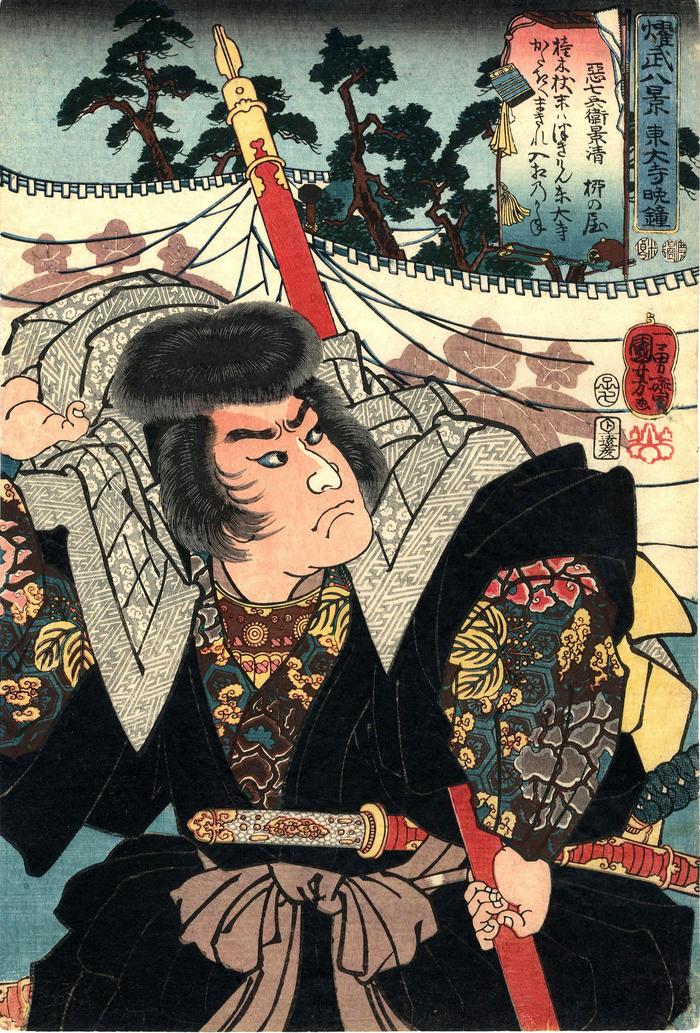Utagawa Kuniyoshi (歌川国芳) (artist 11/15/1797 – 03/05/1861)
Evening Bell at Tōdaiji Temple (Tōdaiji banshō - 東大寺晩鐘) from the series Military Brilliance of the Eight Views (Yōbu hakkei - 燿武八景)
07/1852
14 in x 9.5 in (Overall dimensions) Japanese woodblock print
Signed: Ichiyūsai Kuniyoshi ga
一勇斎国芳画
Seal: kiri
Publisher: Enshūya Hikobei (Marks 055 - seal 21-016)
Censors' seals: Mera and Watanabe
Date: 7/1852
British Museum
Kuniyoshi Project
Museum of Fine Arts, Boston
Victoria and Albert Museum
Nationaal Museum van Wereldculturen (Rijksmuseum Volkenkunde, Leiden) via Ritsumeikan University
Lyon Collection - another copy of this print The curatorial files at the British Museum refer to this as: "Akushichibyoe Kagekiyo, in a Buddhist monk's habit armed with a naginata."
****
Robert Schaap in his Heroes & Ghosts:Japanese Prints by Kuniyoshi 1797-1861 wrote: "Akushichibyōe Kagekiyo (Bad man of the seventh degree) Kagekiyo (died 1195), here seen in the black and grey clothes of a monk holding a naginata (spear). The scene refers to the legend that he went to Nara disguised as a priest with the intention to murder Minamoto Yoritomo (1147-99). He was however discovered and is said to have blinded himself in order to avoid seeing the triumph of his enemy.
This scene is compared with Vesper bell at Tōdaiji (temple) from the Eight views."
See also Robinson The Warrior Prints, p. 156.
****
I don't know if anyone has mentioned this before, and I haven't found any references to this as regards this specific print, but the character of Kagekiyo is standing either just outside the camp of Yoritomo as can be seen by the subtle display of the sasarindō (笹竜胆) motif displayed on the jinmaku (陣幕) or curtain. The sasarindō was Yoritomo's own personal crest and not even that of his clan, the Minamoto.
"The kamon, for example, of the Fujiwara clan shows two tresses of stylised wisteria (fuji) blossom, a visual pun on their name. The personal, rather than clan mon of Minamoto no Yoritomo was the sasarindō, a design in which three flowers of rindō (the Japanese gentian, Gentiana scabra or G. makinoi) sit above three leaves of the shrubby bamboo Sasa. The gentian was characteristic of the damp grassland flora of Southern Japan, while the bamboo was a signature plant of the North. This elegant posy is iconographic code for the shogun: the North is subjugated by the South; the country united under his military authority. The Heike clan took swallowtail butterfly as their badge, suitably flamboyant and fugacious for the high-rolling tribe routed by Yoritomo's Genji."
Quoted from: The Lotus Quest: In Search of the Sacred Flower by Mark Griffiths, p. 245.
****
The text reads: 柳の屋 撞木杖末はつきけん東大寺かたきへまきれ入相のかね
****
Illustrated:
1) in color in Heroes and Ghosts: Japanese Prints by Kuniyosh 1797-1861 by Robert Schaap, Hotei Publishing, 1989, page 108, no. 95.
2) in color in Utagawa Kuniyoshi: 342 Color Paintings [sic] of Utagawa Kuniyoshi by Jacek Michalak, Kindle Edition, 2022, unpaginated.
Enshūya Hikobei (遠州屋彦兵衛) (publisher)
warrior prints (musha-e - 武者絵) (genre)
Taira Kagekiyo (平景清) (role)
